The understanding of our history is rapidly progressing thanks to the ongoing work of archaeologists. Through advancements in technology, our comprehension of past civilizations, extinct species, and other historical puzzles is accelerating, creating an historical record that holds pieces of past epochs concealed beneath the earth’s surface.
Our historical archive contains fragments of people’s lives that offer us glimpses into who they were, the items they treasured, their homes, and the skeletal remains of their disintegrating bodies. Remains that often confirm that life wasn’t always easy or gentle in the past. When history is uncovered, the stories revealed by the archaeological discoveries are sometimes brutal and violent – and sometimes they’re straight out of a horror story.
Here are 25 Most Shocking Archaeological Discoveries.
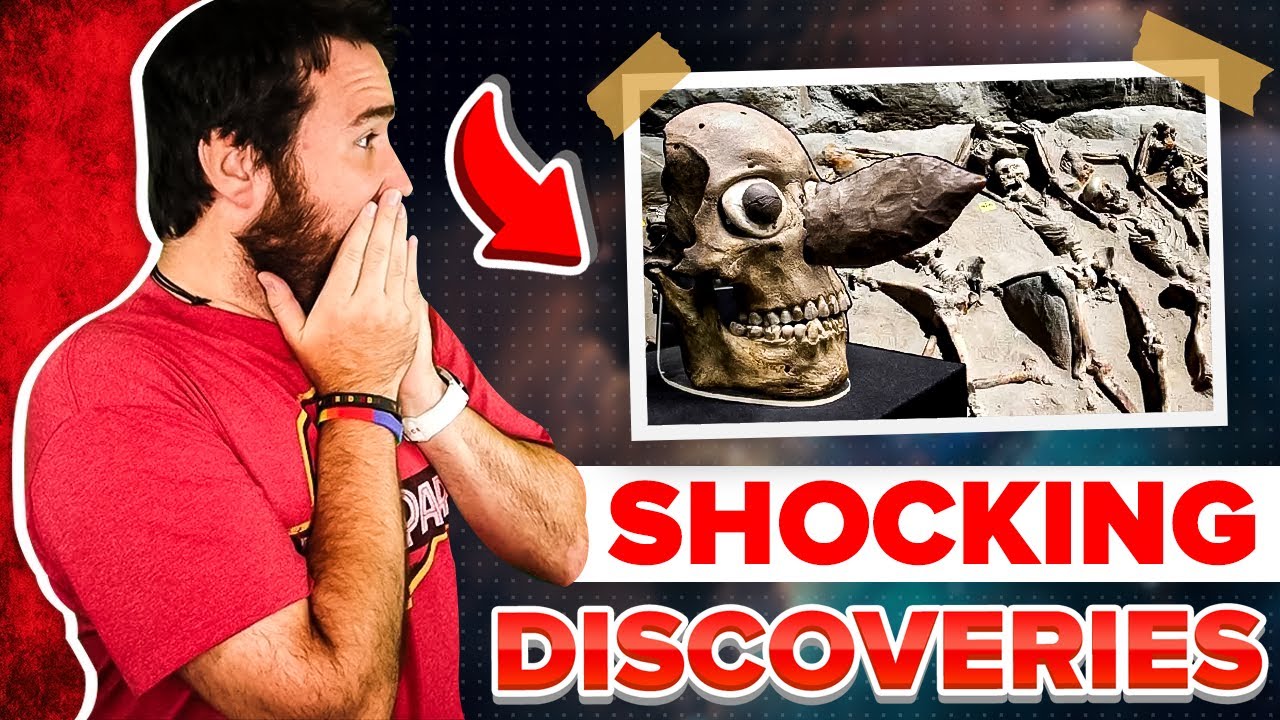
Germany’s 10 Million-Year-Old Teeth
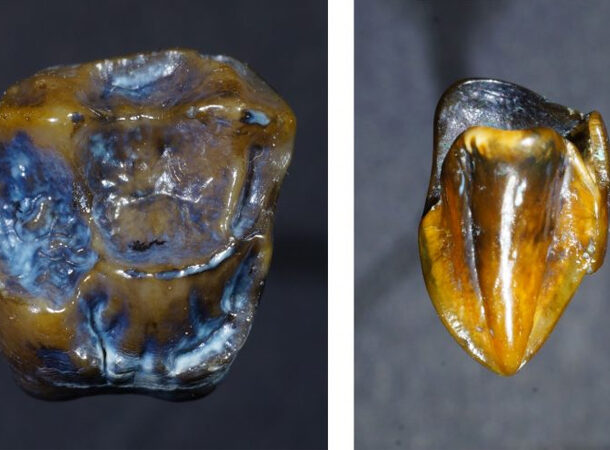 https://www.nationalgeographic.com/news/2017/10/ancient-teeth-found-germany-dont-rewrite-human-history-science/#close
https://www.nationalgeographic.com/news/2017/10/ancient-teeth-found-germany-dont-rewrite-human-history-science/#close We thought we’d get our controversial item in first. Archaeologists unearthed two 9.7 million-year-old teeth in Eppelsheim, Germany, in 2016. They weren’t quite human, but they looked like Lucy’s teeth, a renowned fossil of Australopithecus afarensis, an early ancestor of homo sapiens. The only issue with the discovery was that these teeth were four million years older than Lucy’s. However, National Geographic was quick to caution against sensationalizing the discovery by portraying it as proof that humanity evolved in Europe rather than Africa. (According to Newsweek, the fossils “could rewrite human history.”) The teeth could be from an extinct hominoid monkey only distantly related to humans, or they could be from an entirely new species, possibly even a ruminant mammal. More investigation into this astounding discovery is definitely needed.
The Pit of Bones
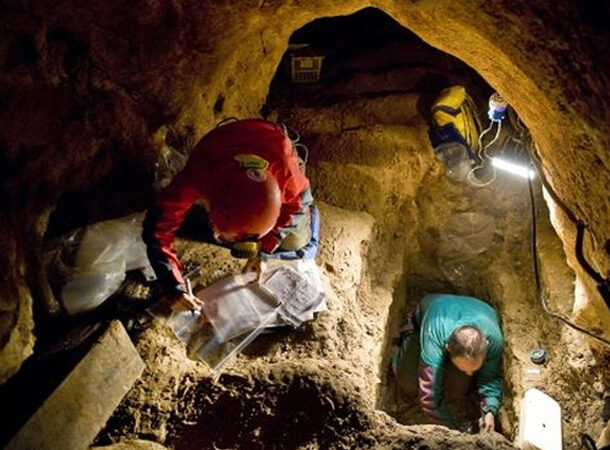 https://www.newscientist.com/article/mg22029462-600-oldest-human-genome-dug-up-in-spains-pit-of-bones/
https://www.newscientist.com/article/mg22029462-600-oldest-human-genome-dug-up-in-spains-pit-of-bones/ In 1987, archaeologists working in Spain’s Atapuerca mountains discovered a cave that held the skeletal remains of 28 people. The bones were dated to 430,000 B.C., and after a lengthy examination of the bones, the experts discovered that one of the deceased had been brutally murdered. They painstakingly reconstructed the skull and found two head wounds. There was no information about the victim’s age or gender, but it was determined that he or she had repeatedly been hit with a blunt weapon, such as a stone ax or spear. Hundreds of thousands of years may have passed before this crime was discovered.
A Mummified Lung
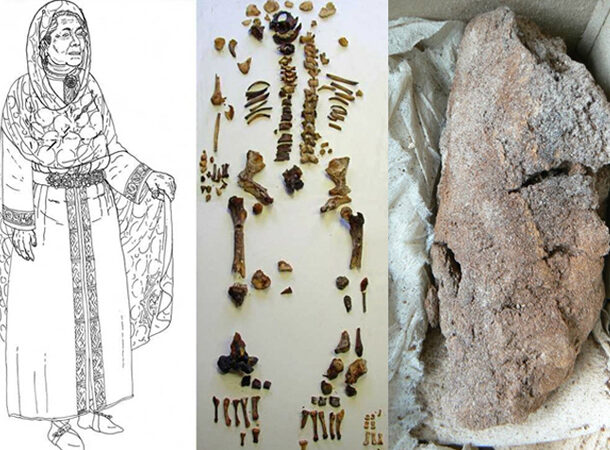 https://www.archaeology.org/news/4391-160418-arnegunde-preserved-lung
https://www.archaeology.org/news/4391-160418-arnegunde-preserved-lung Whole-body mummies are creepy. But when you open a tomb and find nothing but a skeleton and a single, leathery lung, you’ve bypassed creepy and crossed over onto shocking territory. Archaeologists uncovered just that following the excavation of a stone coffin in the Basilica of St. Denis in 1959. The remains belonged to Arnegunde, a queen who lived between A.D. 515 and 580. Nobody could determine why Arnegunde’s body deteriorated while her lung was mummified. In April 2016, researchers solved the mystery. Chemical residues of plant compounds and elevated copper levels in the lung indicated that embalming fluid with herbs and spices was likely injected down her throat after death. The queen was buried with a copper alloy belt, which, along with the embalming herbs, probably preserved her lung due to copper’s antibacterial properties.
Australia’s “Murder Island”
 https://www.mamamia.com.au/murder-island-batavia-story/
https://www.mamamia.com.au/murder-island-batavia-story/ As if Australia didn’t have enough terrifying things, they also have “Murder Island.” The largely unknown site, officially named Beacon Island, gained its nickname due to the events of 1629. That year, the Batavia, a Dutch ship, set sail for the first time, carrying troops, sailors, and civilians to what is now Indonesia. A botched revolt onboard ended in a shipwreck; dozens died. A few hundred surviving travelers were left trapped on Beacon Island. Mutineers went on a killing spree, killing 125 of the survivors. Many of them were assaulted sexually. Almost 400 years later, experts were still uncovering the skeletal remains of the murder victims alongside a few who managed to flee the carnage.
A Pit Of Amputated Arms
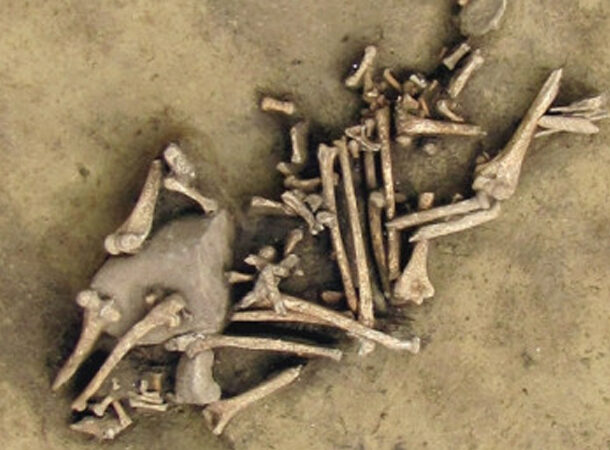 http://www.livescience.com/53341-pit-of-arms-uncovered.html
http://www.livescience.com/53341-pit-of-arms-uncovered.html A team in France discovered a terrible remnant from our past: seven severed arms, one belonging to a child, that were savagely chopped off and dumped into a pit 6,000 years ago. The victims were most likely farmers. After throwing away the arms, the archaeologists discovered the remains of dozens of skeletons stacked on top, all with caved-in skulls.
The specific fate of those who died is not known, but it is obvious that a horrible massacre took place. The researchers believe that losing an arm was a type of social punishment, a less severe destiny for people linked with a group doomed to extinction. However, the identities of those responsible for the murders and their reasons behind the removal of the arms are still a mystery.
Injured Animals In Ancient Egypt
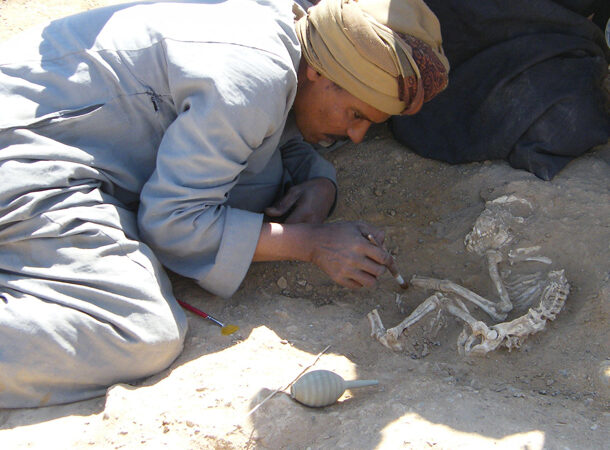 https://www.nationalgeographic.com/history/article/150525-ancient-egypt-zoo-pets-hierakonpolis-baboons-archaeology#:~:text=Baboon%20skeletons%20found%20at%20one,the%20head%20from%20a%20blow.
https://www.nationalgeographic.com/history/article/150525-ancient-egypt-zoo-pets-hierakonpolis-baboons-archaeology#:~:text=Baboon%20skeletons%20found%20at%20one,the%20head%20from%20a%20blow. About 5,000 years ago, Hierakonpolis, situated along the Nile River, was a significant town, even preceding the construction of the pyramids. Its wealthy residents flaunted their status by owning exotic pets. During a cemetery excavation, archaeologists found the remains of two elephants, several baboons, and a hippo, among other animals.
But life for these pets wasn’t all fun and games. The skeletons of some baboons and the hippo showed signs of healed bone fractures, indicating that they might have been injured during capture or while being restrained. These injuries would have required protection and healing care, meaning that these animals were kept in captivity.
The Montezuma Attack
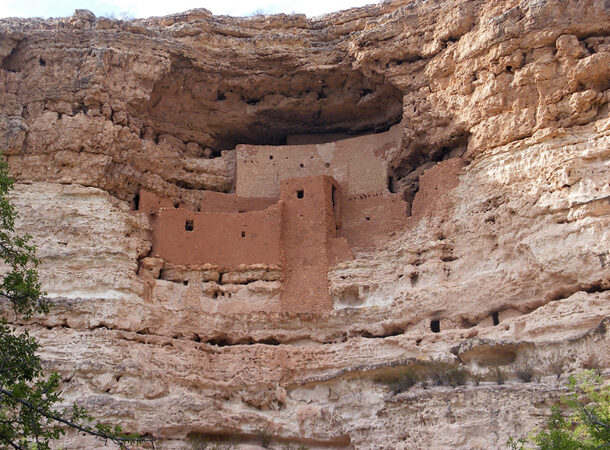 http://westerndigs.org/new-evidence-reveals-violent-final-days-at-arizonas-montezuma-castle/
http://westerndigs.org/new-evidence-reveals-violent-final-days-at-arizonas-montezuma-castle/ Montezuma Castle National Monument in Arizona holds a tragic past. Built around 900 years ago by the Sinagua people, the sudden disappearance of its inhabitants has been a mystery for over eighty years. While initial theories pointed to a “decommissioning ritual” involving a fire before their departure, Hopi and Tonto Apache traditions tell stories of attacks using arson as a weapon to drive them away. Recent investigations support these ancient tales.
The period between 1375-1395 was significant, as pottery production continued, indicating people lived there until the end. In the 1930s, four bodies were found together, initially believed to be older than the fire. But a closer examination revealed a gruesome end – three had fractured skulls, and all showed cut and burn marks shortly before their death. This suggests a brutal attack forced them to leave, but what triggered the assault remains a mystery.
The Alaskan Children In The Hearth
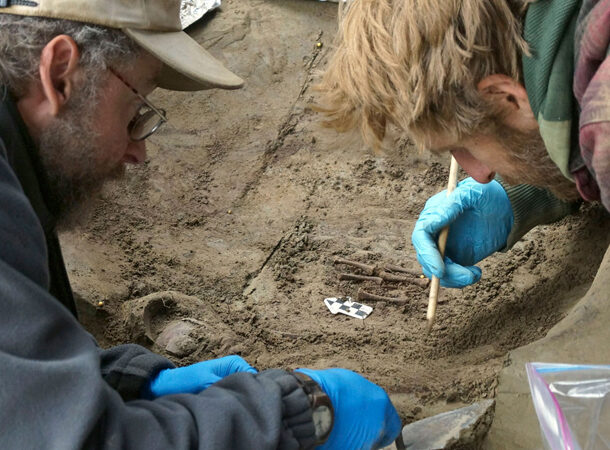 https://www.nytimes.com/2018/01/03/science/native-americans-beringia-siberia.html
https://www.nytimes.com/2018/01/03/science/native-americans-beringia-siberia.html Approximately 11,500 years ago, in central Alaska, a 3-year-old child underwent a cremation ritual and was interred within a hearth. In 2010 archaeologists found the remains. They also discovered the remains of two infants they named Xach’itee’aanenh T’eede Gaay and Yełkaanenh T’eede Gaay. Analysis of their mitochondrial DNA revealed they had different mothers but shared genetic similarities with living Native Americans.
Although DNA retrieval from Yełkaanenh T’eede Gaay’s remains was challenging, the team successfully reconstructed the entire genome of Xach’itee’aanenh T’eede Gaay. Their findings revealed that she belonged to an unknown population called Ancient Beringians. These people genetically diverged from the ancestors of Native Americans approximately 20,000 years ago and occupied a unique position in the Native American family tree. The discovery has provided vital insights into the Americas’ early human history.
The First Case of Hepatitis B
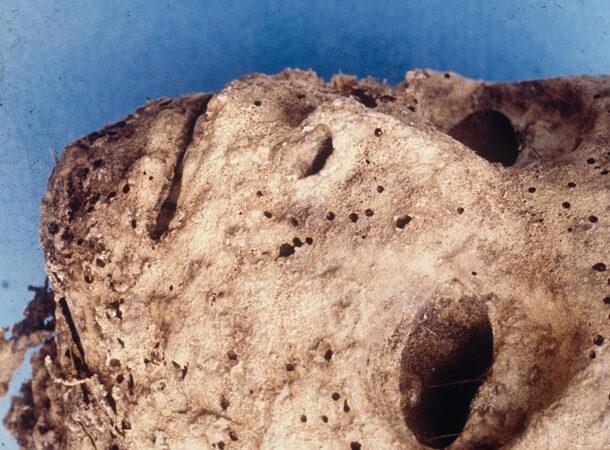 http://journals.plos.org/plospathogens/article?id=10.1371/journal.ppat.1006750
http://journals.plos.org/plospathogens/article?id=10.1371/journal.ppat.1006750 Recently, scientists used advanced DNA sequencing on a child’s mummy from the 16th century to learn more about Hepatitis B (HBV) and its history. This DNA data is the oldest evidence of the virus, suggesting that humans might have lived with HBV for hundreds of years and even evolved alongside it. The researchers studied the well-preserved remains of the 450-year-old child buried in Naples, Italy, and this new genetic data has shed more light on HBV’s roots and development. Before, they wrongly thought the child had smallpox, making it the earliest known case of smallpox. However, now they know that HBV, not smallpox, actually caused the child’s terrifying facial rash. It goes to show just how challenging it can be to identify diseases from the past, not to mention what archaeologists are exposed to when uncovering ancient graves.
The Man-Eating Animals Of Teotihuacan
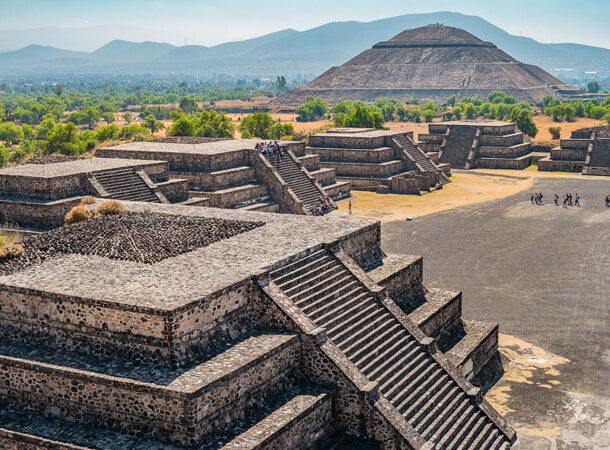 http://ancientamericas.org/forum/new-research-animal-remains-teotihuacan#:~:text=The%20remains%20were%20of%20wolves,as%20part%20of%20ritual%20sacrifice.
http://ancientamericas.org/forum/new-research-animal-remains-teotihuacan#:~:text=The%20remains%20were%20of%20wolves,as%20part%20of%20ritual%20sacrifice. Archaeologists recently discovered what looked to be a den where wild animals were kept inside Teotihuacan, the ancient Mesoamerican city. There, dangerous animals such as jaguars, pumas, and lynxes were observed while they waited for the priests to sacrifice them to the gods. The bones of the animals they’d been fed were still there thousands of years later. Scattered among the animal bones, archaeologists also discovered another type of discarded remains – that of humans. Testing on the animals’ bones revealed that they had residues of maize in their diet. In Teotihuacan society, maize was far more likely to arrive by eating people than vegetables. There’s also artwork on the walls depicting these animals devouring human hearts. It appears that the priests of Teotihuacan dragged victims into these dens. Here they were thrown to the jaguars and pumas, either as punishment or ceremony, and became the animals’ food.
The Hanging Coffins
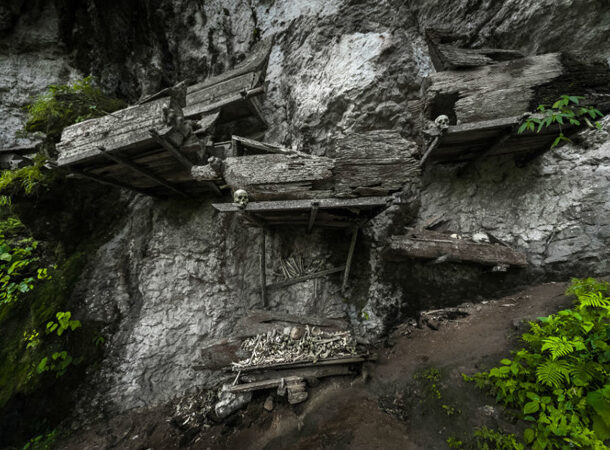 http://www.scmp.com/news/china/society/article/1891298/131-ancient-chinese-hanging-coffins-found-side-100m-cliff-near
http://www.scmp.com/news/china/society/article/1891298/131-ancient-chinese-hanging-coffins-found-side-100m-cliff-near The Cave of the Fairies is a man-made cave in Hubei, China. It was once thought that mystical entities dwelt in the cave. However, when archeologists finally looked inside, they discovered something very different. 131 ancient, decomposing coffins hung up to 50 meters (165 feet) over their heads. Some coffins hung from wooden posts, while others were pushed into rock openings. The coffins were enormous. Each weighed more than 220 lb and was cut from a single tree trunk. Unfortunately, some of them had been torn apart and broken up. The coffins were all built by the ancient Bo people 1,200 years ago. They were believed to have been hung as part of a religious ritual to bless the dead and discourage wild animals from eating their remains.
The destruction occurred a mere 50 years ago. Someone discovered the coffins in the 1960s and, rather than announcing the discovery, tore the wood out to use as firewood—desecrating the ancient graves for a few seconds of warmth.
He, with the Knife-Arm
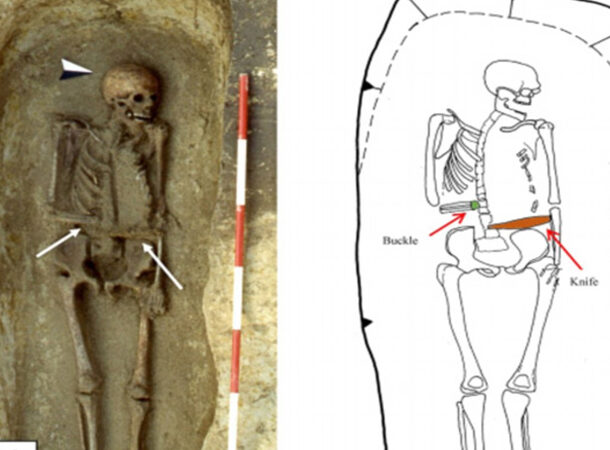 https://www.smithsonianmag.com/smart-news/medieval-man-used-knife-prosthetic-limb-180968837/
https://www.smithsonianmag.com/smart-news/medieval-man-used-knife-prosthetic-limb-180968837/ Archaeologists in northern Italy unearthed fascinating remains at a mass burial site dating from the 6th to 8th century CE in 2018. One of the victims was a middle-aged man who had his arm severed below the elbow… And then replaced it with a knife. Further investigation revealed that he had used the weapon as a prosthetic. Extreme wear on his teeth and a peculiar bone ridge in his shoulder all indicated that he had been wearing the knife with straps that he repeatedly tightened with his lips. They also discovered a clasp and other decomposed material near the sharp prosthetic, which they assumed was leather. Serious medieval badass or a frightening historical serial killer? We’ll let you decide.
Aztec Skull Rack and Towers
 https://www.science.org/content/article/feeding-gods-hundreds-skulls-reveal-massive-scale-human-sacrifice-aztec-capital
https://www.science.org/content/article/feeding-gods-hundreds-skulls-reveal-massive-scale-human-sacrifice-aztec-capital Given the Aztec tradition of human sacrifice, it is not surprising that hundreds of human skulls have been unearthed in Aztec temples. An immense tzompantli, or skull rack, loomed outside the Templo Mayor in the Aztec metropolis of Tenochtitlan. The skulls were not just for décor; they were also spiritual symbols. In 2015, archaeologists discovered two towers flanking the skull wall. The towers were likewise composed exclusively of human skulls. Archaeologists from the National Institute of Anthropology and History estimated that the rack and walls once held thousands of skulls, demonstrating the immense extent of human sacrifice. These skulls were most likely from sacrificial victims and enemy soldiers. Archaeologists believe that after the skulls on the rack began to decompose, they were moved to the towers.
Celtic Hybrid Boneyard
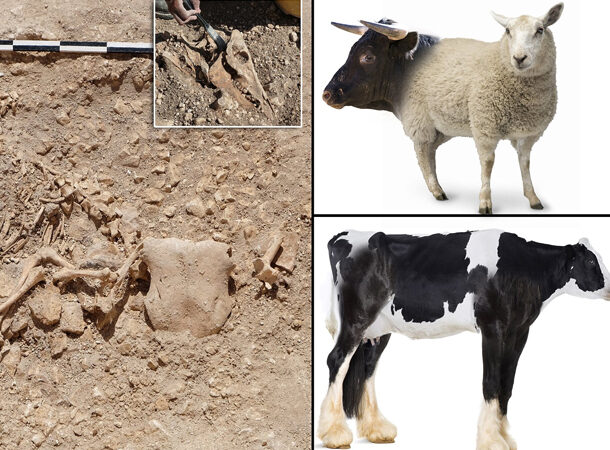 http://www.independent.co.uk/news/science/archaeology/news/the-boneyard-of-the-bizarre-that-rewrites-our-celtic-past-to-include-hybrid-animal-monster-myths-10381965.html
http://www.independent.co.uk/news/science/archaeology/news/the-boneyard-of-the-bizarre-that-rewrites-our-celtic-past-to-include-hybrid-animal-monster-myths-10381965.html Until recently, we didn’t believe hybrid monsters existed in Iron Age Celtic mythology. Now, one Dorset gravesite reveals that the Celts had their own fabled monsters that they constructed in real life. The discovery was made in Duropolis. The “cemetery” contains pits filled with animal skeletons that have been rearranged to make hybrid beasts. It includes a sheep with a bull’s head on behind and a cow with horse legs. The most unusual find was a woman’s skeleton on top of a layer of animal bones that resembled the layout of the human skeleton. Her head was mounted on a “bed” of animal skulls, her legs on top of animal leg bones…
Archaeologists believe that the skeletal remains, including those of a woman, were symbolic of sacrifices. Initially, the pits were utilized for storing food. However, when it was time to create a new pit, a sacrifice was placed in the old pit and buried.
The Frankenstein Mummies
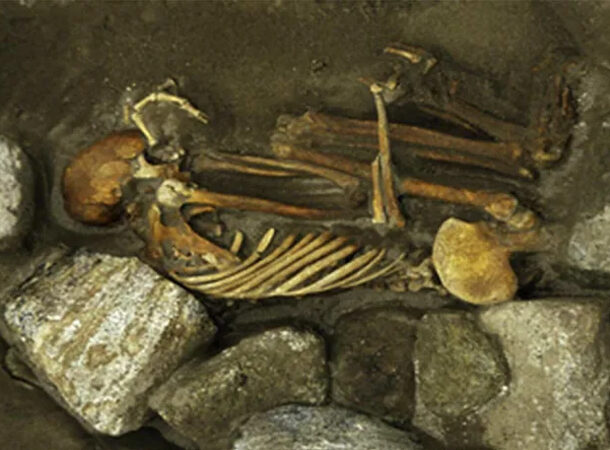 https://www.nbcnews.com/id/wbna48123087
https://www.nbcnews.com/id/wbna48123087 Our ancestors did not only come up with hybrid beasts. The inexplicable, as in this case, is often the most creepy. During an excavation at a Bronze Age hamlet in Scotland in 2001, archaeologists unearthed the skeletons of a man and a woman. The skeletons were around 3000 years old and had been intentionally mummified – in this case, stored in peat bogs to halt decomposition. However, upon closer study, researchers discovered something disturbing: the skeletons included parts from several bodies. The “woman” was made up of a male head, a female torso, and an unidentifiable arm, while the “man” was made up of bones from three different individuals. Simply put, the archaeologists had discovered a human skeleton jigsaw puzzle with no guidelines or explanations.
Cannibalism in the Arctic
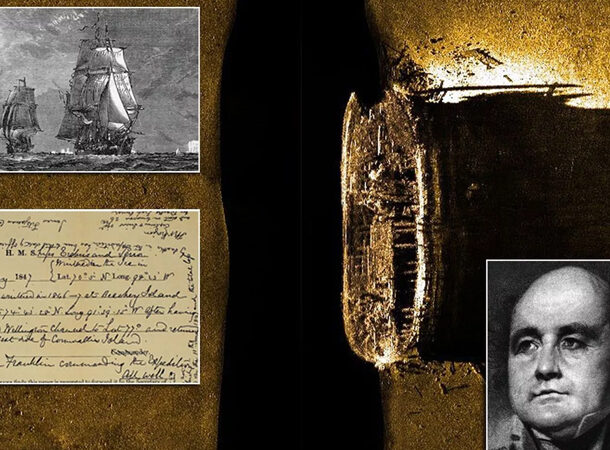 https://www.smithsonianmag.com/smart-news/franklins-doomed-arctic-expedition-ended-gruesome-cannibalism-180956054/
https://www.smithsonianmag.com/smart-news/franklins-doomed-arctic-expedition-ended-gruesome-cannibalism-180956054/ Sir John Franklin and his crew set out on their Arctic voyage in 1845, hoping to find the Northwest Passage. They definitely did not anticipate resorting to cannibalism within the next few years. The two ships of the expedition, the HMS Terror and the HMS Erebus became stuck in ice that refused to melt summer after summer. By April 1848, 24 men were deceased, and the survivors embarked on a journey to the nearest trade post. Nobody heard from them again. Some of the crew members’ bones were discovered over time. Researchers stated in the Journal of Osteoarchaeology in 2015 that the bones had been cut, cooked, and broken to get the marrow inside. This discovery speaks to the terrible circumstances in which those men found themselves. It makes me wonder, what would you do if you found yourself in such a situation?
Largest Mass Child Sacrifice
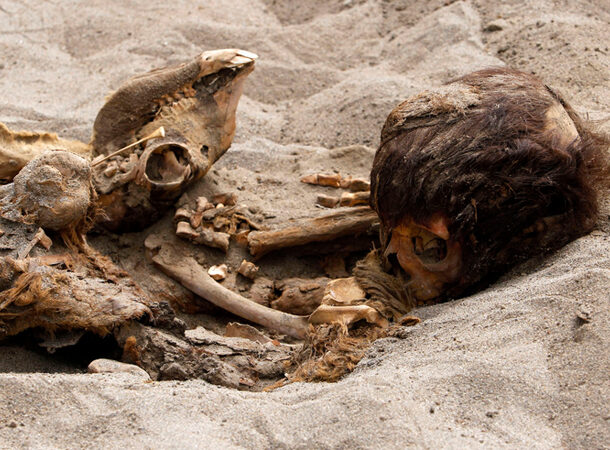 https://www.theguardian.com/world/2019/aug/29/peru-huanchaco-sacrificial-site-skeletons
https://www.theguardian.com/world/2019/aug/29/peru-huanchaco-sacrificial-site-skeletons In 2019, archaeologists in Peru discovered what is considered the largest single mass child sacrifice in history. The bodies of 227 children, ages five to fourteen, were discovered near the beach town of Huanchaco, north of Peru’s capital Lima. The children were thought to have been sacrificed around 500 years ago. Many of the children still had their hair and skin when they were uncovered. The children were put to death during wet weather and buried facing the sea, indicating that they were sacrificed to placate the Chimú’s gods. According to archaeologists, a catastrophic El Niño climate event may have destabilized the Chim kingdom’s economy, prompting its priests to arrange mass sacrifices to convince the gods to stop the rain.
Bones In A Tree
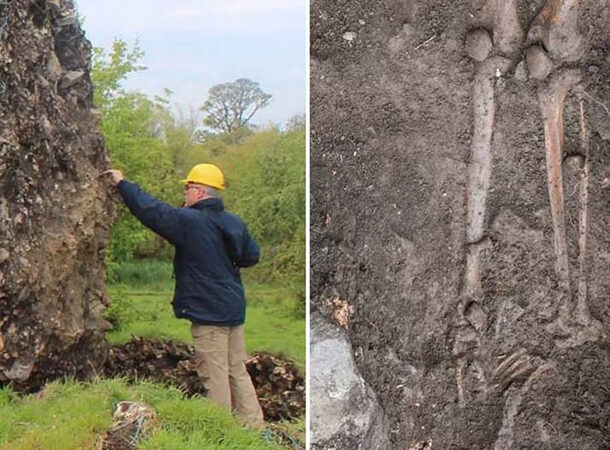 https://www.cbsnews.com/news/medieval-skeleton-discovered-under-uprooted-tree/
https://www.cbsnews.com/news/medieval-skeleton-discovered-under-uprooted-tree/ A season 6 episode of the crime drama “Bones” showed the discovery of a skeleton with a dogwood tree growing through it. As it so often goes, truth is stranger than fiction, and it just so happens that something similar actually happened in Ireland, but the tree was a beech. In Collooney, Ireland, a 215-year-old tree toppled after a winter storm in 2015. A mound of bones was twisted in the roots. They were later found to be the remains of a child who died between 1030 and 1200. The revelation was made much more disturbing by the discovery of knife marks on the boy’s ribs and hands, indicating that his death was violent.
A Toothy Tumor
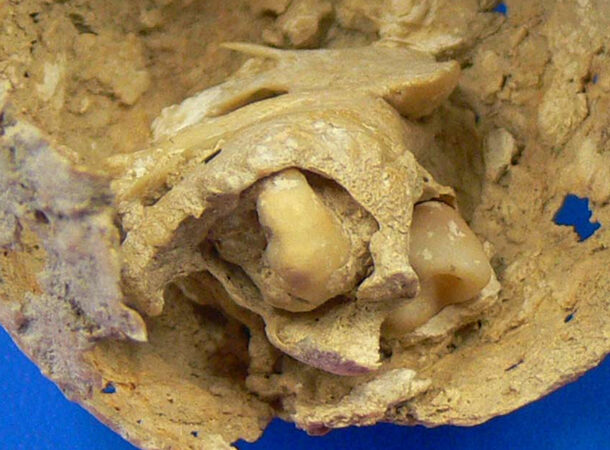 https://www.nbcnews.com/id/wbna50549575
https://www.nbcnews.com/id/wbna50549575 When Spanish archaeologists discovered the 1,600-year-old skeleton of a Roman woman, they were shocked by what they found in her pelvis. A calcified bone ball with four deformed teeth sprang out from between her hips. This unpleasant discovery was an ovarian teratoma, a type of tumor that develops from germ cells. As the precursors of human egg cells, germ cells can generate body parts such as teeth and bones. The most common teratomas, like the one in the Roman woman’s pelvis, are benign. Archaeologists believe the woman died as a result of tumor complications, although she may never have known the toothy ball existed.
The Sacrificial Pits of Shimao
 https://www.forbes.com/sites/kristinakillgrove/2018/08/30/human-sacrifices-at-massive-pyramid-along-great-wall-change-archaeologists-view-of-early-china/?sh=3613a2b844b9
https://www.forbes.com/sites/kristinakillgrove/2018/08/30/human-sacrifices-at-massive-pyramid-along-great-wall-change-archaeologists-view-of-early-china/?sh=3613a2b844b9 Shimao, an ancient site along China’s Great Wall, houses a fortified Bronze Age city topped by a stepped pyramid. Researchers discovered at least six trenches containing human skulls beneath the pyramid during excavations. Further examinations of the skulls revealed that they belonged to 80 young girls, suggesting they might have been victims of human sacrifices. In ancient China, sacrifices were actually not that rare and were frequently dedicated to the river god Hebo. Additionally, sacrifices were sometimes carried out as funeral ceremonies, where slaves would be buried next to their masters or concubines with their rulers. Unfortunately, the exact reasons behind the sacrifice of these 80 young girls remain a mystery.
Shackled Skeletons
 https://www.reuters.com/article/us-greece-archaeology-executions-idUSKCN10C1X5
https://www.reuters.com/article/us-greece-archaeology-executions-idUSKCN10C1X5 At least 80 chained skeletons were discovered in Palaio Faliro, an Athens neighborhood in 2016. The skeletons are frightening to see. Their wrists are bound, and many lie with their mouths wide as if they were screaming when they died. The skeletons belonged to young men who were all in good health when they died. Archaeologists believe that these men were devotees of Cylon, the nobleman and Olympic champion who attempted to conquer Athens in the 7th century BCE. The controversial incident was known as the Cylon Affair. Following the failure of Cylon’s coup, his followers sought refuge at Athena’s temple on the Acropolis. According to the historian Thucydides, the devotees were murdered immediately after leaving the temple. Pottery discovered at the site assisted archaeologists in dating the burials to the time of the coup.
Decapitated Gladiators
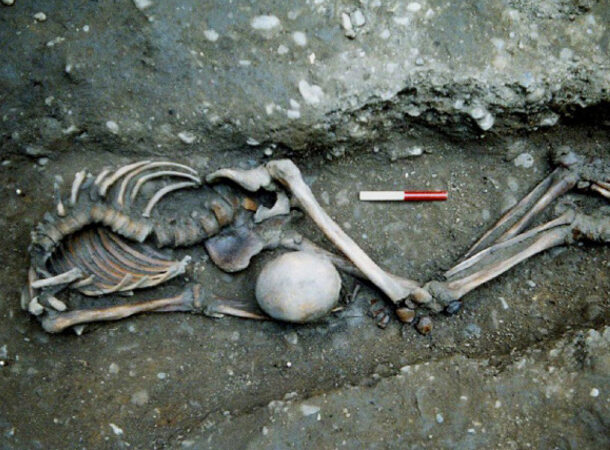 https://www.livescience.com/53512-decapitated-roman-gladiators-revealed.html
https://www.livescience.com/53512-decapitated-roman-gladiators-revealed.html In 2016, archaeologists uncovered a group of skeletons in the U.K. that all belonged to tall men who had died before they turned 45. What made the find particularly gruesome was that they had all lost their heads. The heads were found on their chests and others between their legs or feet. The men all lived between the second and fourth century A.D., during the reign of the Northern Roman Empire. Because most skeletons were unusually tall and showed evidence of trauma, researchers concluded they had all been gladiators. DNA testing on seven beheaded skeletons revealed that six were from the United Kingdom, while the seventh was from Lebanon or Syria.
Neolithic Genocide In Austria
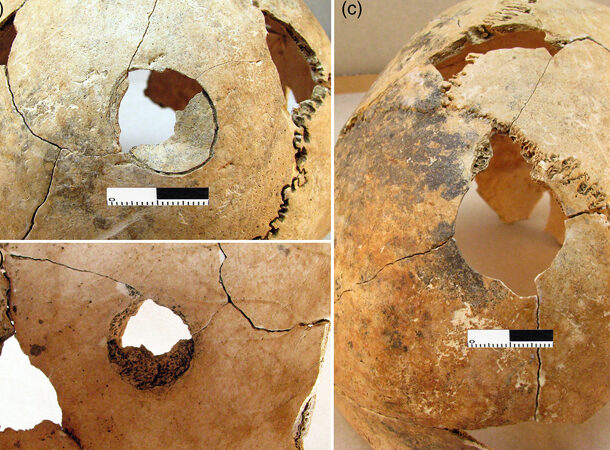 http://www.livescience.com/51884-neolithic-massacre-mass-grave.html
http://www.livescience.com/51884-neolithic-massacre-mass-grave.html In 2015, a team of archaeologists found the skeletal remains of 67 people in a grave near Asparn-Schletz, Austria. The remains told a terrifying story. The people died in 5200 BC, fleeing for their lives in what had been the systematic slaughter of an entire tribe. The men and children were butchered while running, with the majority receiving blows in the back of the head. Several were shot down with arrows, and many had their legs crushed and broken to prevent their escape before they were ultimately murdered. 27 Children died. All but two of the bodies belonged to men. Archaeologists believe that the rest of the women were forced to watch the murders of their husbands and children and were then taken as slaves to serve the men who had brutally murdered their families.
The Cannibalized Remains Of Herxheim
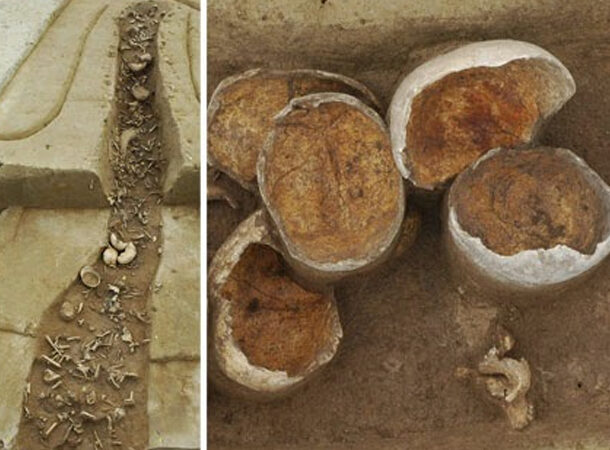 https://www.academia.edu/9225784/Boulestin_B._Zeeb-Lanz_A._Jeunesse_C._Haack_F._Arbogast_R.-M._Denaire_A._2009_Mass_cannibalism_in_the_Linear_Pottery_Culture_at_Herxheim_Palatinate_Germany_._Antiquity_vol._83_p._968-982
https://www.academia.edu/9225784/Boulestin_B._Zeeb-Lanz_A._Jeunesse_C._Haack_F._Arbogast_R.-M._Denaire_A._2009_Mass_cannibalism_in_the_Linear_Pottery_Culture_at_Herxheim_Palatinate_Germany_._Antiquity_vol._83_p._968-982 A construction crew in Herxheim, Germany, encountered something genuinely terrifying. Underneath the land where they intended to build was a big hole filled with dead bodies – over 1,000 in total. The remains had been buried there for almost 7,000 years. But whatever happened to them was a destiny worse than death. They hadn’t just been murdered. Their skulls had been scraped clean. Like a butcher preparing a pig, their ribs had been pulled off their vertebrae. Some of the bones had been shattered, and the marrow sucked out. These people, in fact, appeared to have been scalped, killed, skinned, and cannibalized.
To make matters worse, the slaughter was not a desperate act of starving people. There were over 1,000 victims, and how they were skinned was far too ritualistic. This was not a passion crime or a transitory slip in rationality. It was an organized ritual that a whole community had come together to perform.
Oldest Ever Shark Attack Victim
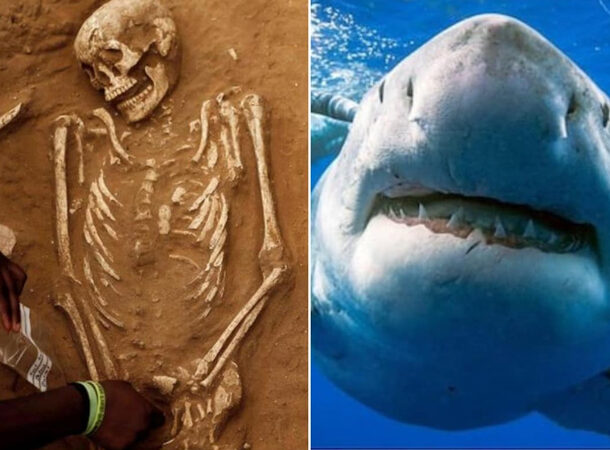 https://www.smithsonianmag.com/smart-news/archaeologists-uncover-3000-year-old-shark-attack-victim-180978076/
https://www.smithsonianmag.com/smart-news/archaeologists-uncover-3000-year-old-shark-attack-victim-180978076/ Over 3000 years ago, one of our ancestors walked into the ocean for a swim or to fish and got much more than he bargained for. He was attacked by a shark and died from his injuries. In 2019, archaeologists discovered his body, which has now become the first direct evidence of a shark attack on a human being. The discovery was made by experts from the University of Oxford while examining his skeletal remains – excavated at the Tsukumo site near Japan’s Seto Inland Sea. The 3000-year-old remains had over 790 traumatic injuries covering the arms, legs, abdomen, and chest. After going through a process of elimination, the experts conclusively excluded human conflict and more commonly reported animal predators or scavengers and confirmed that the shark most likely responsible for the attack was either a great white or a tiger shark.



























